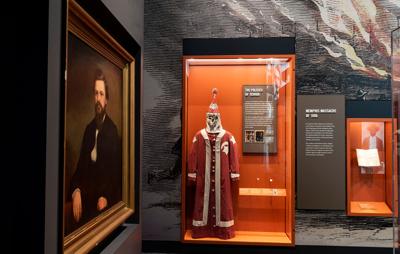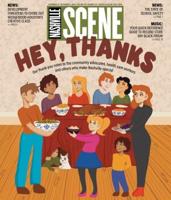The roots of white supremacist organizations in Nashville are somewhat hard to trace since the whole Southern slaveocracy was a white supremacist organization. But it may be fair to start with the granddaddy of all current hate groups, the Ku Klux Klan.
The Klan was founded in late 1865 or early 1866 down in Pulaski, Tenn., by Frank McCord, Richard Reed, John Lester, John Kennedy, J. Calvin Jones and James Crowe. Soon after, famed Confederate Gen. Nathan Bedford Forrest was inducted as the first Grand Wizard of the Klan here in Nashville at the Maxwell House Hotel. Their headquarters was, supposedly, Fort Negley, but newspapers at the time were complaining about the “scoundrel, Leander Woods” a United States Colored Troops vet who, along with his 50-man militia, operated out of the fort during this time. It’s doubtful they shared the space. Once Reconstruction failed, this version of the Klan fizzled out. Racists no longer needed a secret society through which to terrorize Black people; they could just use the power of the government they came to control.
The 1915 release of D.W. Griffith’s film The Birth of a Nation is often credited by historians with the revitalization of the Klan in the United States. Like just about everywhere else, the movie was wildly popular in Nashville and was even made into a play that also was very popular in town. Black ministers, however, denounced the play and called on the mayor to ban it, because “this play never fails to stir up race feelings between the blacks and whites as no other drama does on the American continent to-day.” (Nashville Banner, May 2, 1918, page 4).
But interestingly enough — in spite of the popularity of the Klan throughout the nation and many letters to the editors in the paper blaming anti-Klan sentiment on people trying to destroy President Roosevelt — white people in Nashville seemed only to know someone who used to be in the Klan. When you consider how widely popular the Klan was in the ’20s and ’30s nationally, it is strange that more Nashvillians at the time weren’t bragging about their ties to the organization. It could be that Nashville, with its close ties to the original Klan, felt this new iteration was a little gauche. It’s hard to be an elite secret terrorist organization when said organization — during its second iteration, at its height — had 2 million people in it.
By 1915, we did have The Fugitives, a group of poets affiliated with Vanderbilt University — including original Klansman James Crowe’s nephew, John Crowe Ransom — who were devoted to creating a poetics of the South. This group later morphed into the Agrarians, another small group of elite white thinkers who were trying to reframe the South as a tragic Camelot. Poet Donald Davidson was a member of both groups.
Even as the Klan faded away yet again, Nashville was not without racists and racial terrorists. There were more than 50 cross burnings in Davidson County in the 1950s before the third wave of the Klan was very active. But then hit Brown v. Board of Education in 1954, and in response, the Nashville Catholic Diocese integrated Father Ryan High School and Cathedral High School. Catholic segregationists swarmed to the Klan, and Klan leader Emmett Carr made regular appearances — maskless — in the papers. Once Nashville announced plans to follow suit and desegregate the city’s public schools, the Klan roared back to life and announced its presence with three bombings: Hattie Cotton Elementary School in 1957, the Jewish Community Center in 1958 and the home of city Councilmember Z. Alexander Looby in 1960.
By the mid-1960s, the Klan in Nashville had split into two factions — the Dixie Klan out of Chattanooga and the United Klans of America, being run at that time out of Alabama. The leaders of the Dixie Klan were members of the Brown family and their close compatriots. The leader of the UKA in Tennessee by 1965 was, effectively, J. Edgar Hoover. In 1967, Hoover put out a secret report titled “Ku Klux Klan Investigations FBI Accomplishments,” in which he explained how things worked in Tennessee:
In the early stages of Klan growth in the State of Tennessee, we were able to develop as a Bureau informant the Grand Dragon of the United Klans of America, Realm of Tennessee. Through this high-level source we were able to control the expansion of the Klan. More importantly, we were able to discourage violence throughout the state. The Klan in Tennessee has not expanded to the proportions it has in other states and its lack of success can be attributed to our highly placed informant. (FBI, 62-116395 n.d.)
Information about the FBI’s control of the Klan in Tennessee is hard to come by. When did it start? How long did it go on? The Tennessean in 1981 learned that Tennessee Imperial Wizard Bill Wilkinson had been an informant for the FBI since 1974. So it seems to have gone on from at least the mid-’60s through 1981.
Nazis had been on the fringes of Nashville racial circles since the 1950s, when George Lincoln Rockwell, who would go on to found the American Nazi Party, came to Tennessee to help organize the National States’ Rights Party, a political party full of Klan members devoted to segregation. But mostly “Nazi” was an epithet used by Klan members to denote more violent racists and not membership in an actual separate group. However, by the late 1970s, there were open Nazis in white supremacist circles here in Nashville. When racial terrorists attempted to bomb Nashville’s The Temple in 1981, the bombing team was made up of Klan members and neo-Nazis.
Starting with the second iteration of the Klan, Nashville racists were constantly striving to be seen as good people with perhaps quirky beliefs. When local racist Jack Kershaw was hanging out with poet Donald Davidson at Vanderbilt in the 1940s, they believed themselves to be classy — the best of what the South had to offer. When Kershaw was using money Donald Davidson and his buddies in the Tennesseans for Constitutional Government raised in the 1950s to bail segregationists out of jail, it was understood that as sympathetic as Davidson, Kershaw and their friends were to the segregationist cause and as supportive of it as they were, they were not the kinds of men who went to jail about it. That was for the rabble.
In the 1990s, when Kershaw was a founding member of the League of the South, they fostered for themselves a similarly classy, yet quirky, and ultimately harmless reputation. Yet by the time of the Unite the Right rally in Charlottesville, Va., in 2017, the League of the South was openly in cahoots with the National Socialist Movement, the Traditionalist Workers Party and Vanguard America (which has now morphed into Patriot Front).
Back in the 1950s and 1960s, Nashville didn’t have a very well organized White Citizens Council. This was due in part to the fact that middle-class white people were openly members of the Klan and had no shame in it, and due partially to the existence of the Tennesseans for Constitutional Government and their offshoot groups, like the Parents Preference Committee, which already was a group for segregationists who didn’t want to be associated with the Klan.
But eventually we did have a chapter of the Council of Conservative Citizens, a descendant group of those White Citizens Councils. Even now the CCC advocates against race mixing, immigration and feminism. In 2008, Sheriff Daron Hall went to speak to the Middle Tennessee Council of Conservative Citizens about his department’s participation in the controversial federal 287(g) program. When asked why he would speak to a known and self-avowed white supremacist group, Hall’s spokesperson responded: “He went before that group to provide information about a program that the sheriff’s office participates in. Period. It was not an endorsement of this organization.” Still, our sheriff went to speak to a white supremacist group. It was not a good look for the sheriff or the city.
The most significant addition to the white supremacist landscape in Nashville has been the decade-long residency of the American Renaissance Conference at Montgomery Bell State Park. American Renaissance touts itself as America’s premier race realist website. The editor, Jared Taylor, is also deeply involved with the Council of Conservative Citizens. Thanks to him and his gathering, white supremacists are able to network while listening to lectures from speakers like John Derbyshire, Richard Spencer, Nick Fuentes, Patrick Casey, Michelle Malkin and former U.S. Rep. Steve King, among others.
In 2018, a different conference headed up by the aforementioned Council of Conservative Citizens and the American Freedom Party brought racists like former Klan leader David Duke and Michael Hill of the League of the South to Montgomery Bell State Park to, again, allow our local racists to hobnob with national figures and network with each other.
The one thing these conferences have illustrated is that, though the names of the groups these folks affiliate with change over time, the people in the groups are pretty consistent and they know or know of each other, going back decades. They’re having long, sustained conversations about their goals and how to achieve them, but we keep treating each time they hit the news as a novel, albeit scary, event instead of as a part of a long tradition of such events in Nashville.
Examining the history of white supremacy in Nashville, modern far-right hate groups, and Williamson County as a seat of right-wing politics






